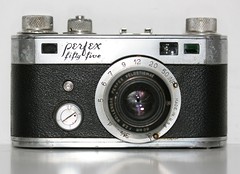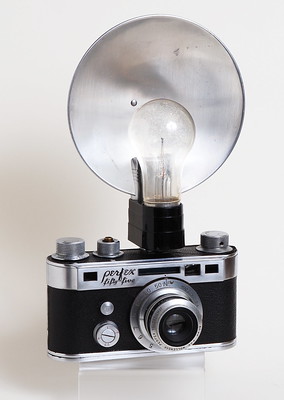Perfex
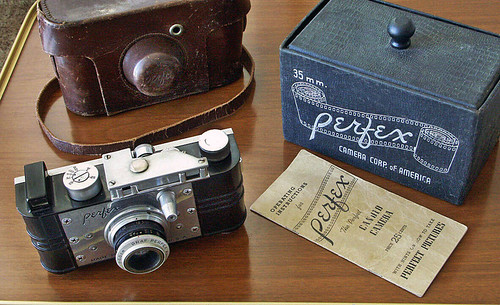
|
| Perfex with cable release adapter image by eBayer renaissanceart (Image rights) |
Perfex was the brand name used by Candid Camera Corporation of Chicago, Illinois, founded by Carl and Joseph Price together with Benjamine Edelman. The company focussed on 35mm rangefinder cameras, but also produced a double 8mm movie camera. Perfex cameras were in production from 1938 through 1950.
Perfex Cameras
1938

|
| Perfex Speed Candid image by Simon Spaans (Image rights) |
The first Perfex camera was the 1938 Speed Candid. This camera takes 135 film, and has a built-in extinction light meter, an uncoupled rangefinder, and a cloth focal plane shutter with speeds up to 1/500 of a second. It has a Bakelite body, styled like a contemporary Argus. It was available with either an f3.5 or f2.8 50mm Graf Perfex Anastigmat lens. Early models are distinguished by the use of a capital "P" in the name "Perfex" engraved into the front plate. These early models are rare compared to the versions with the lower-case "p" in the nameplate.
Speed Candids were originally supplied with small conical fittings that screw over the shutter release button to provide for cable release attachment. These fittings are easily lost and are rarely seen today.
1939 to 1941
The Forty-Four quickly superseded the crude Speed Candid in 1939. This model has a more cleanly styled body, a coupled rangefinder, a hot shoe, and shutter speeds from 1 second to 1/1250 second. The Forty-Four became the basis for all Candid Camera Corp cameras built from 1939 to around 1948.
The Perfex Forty-Four features some very ambitious specs for its time, including a built-in light meter (albeit an extinction meter), exposure calculator, coupled rangefinder, and built-in flash synch. It and the subsequent Thirty-Three and Fifty-Five models are perhaps the only pre-war cameras that provide all of these features built-in. Although the Univex Mercury is credited with being the first camera with internal flash synch via a flash hot shoe as standard equipment, the Perfex Forty-Four is a close second, having been introduced only a few months after the Mercury.
With this camera the photographer ostensibly does not need to carry any other equipment to measure light values or focus distances. Its rangefinder focus base is very wide, nearly the same width as the famously wide focus base of the contemporary Contax II, which allows more accurate focusing. However, while the Contax provides a high quality prism-based rangefinder, the Perfex includes only a simple mirror-based rangefinder. The Perfex top shutter speed of 1/1250 second matches the fastest shutter speed of the Contax II as well.
The Perfex was heavily marketed as a true American-made competitor to the German Contax and Leica cameras at the time, which cost four to five times the price of the Perfex. Although the camera was feature-laden, it did not match the reliability and quality of the German cameras.
Early models of the Forty-Four feature two levers prominently on the face of the camera: the upper lever is the film rewind release lever, and the lower lever is used to engage slow shutter speeds on the camera. Late in the Forty-Four production run these levers were replaced by a button for the film rewind release, and a dial for the slow shutter speeds. This button and dial arrangement was borrowed from the Fifty-Five series and likely was a result of using up old Forty-Four nameplates on Fifty-Five-based camera bodies.
The Forty-Four and all of its derivatives (Thirty-Three, Fifty-Five, Twenty-Two, and deLuxe) include many main features in common, such as the basic body shape, primary controls, lens mount, and general layout. None of these cameras provide eyelets for attaching neck or wrist straps, and therefore must use an eveready case to be carried without a camera bag. All of these cameras were originally sold with a special detachable adapter for fitting a cable release; these adapters screw into threads on the inside of the shutter speed setting dial surrounding the shutter release button, permitting a standard cable release to then be screwed into the adapter above the shutter release button. Because the adapter covers and prevents the normal finger use of the shutter release button, it is only attached to the camera when a cable release is used. As a result, because the adapter itself is very small and easily misplaced or forgotten, these original cable release adapters are rarely seen today.
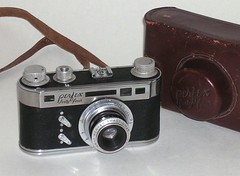
|
| Perfex Forty-Four, early model with two levers image by Rick Oleson (Image rights) |

|
| Perfex Forty-Four, late model with slow shutter speed dial image by HamWithCam (Image rights) |
The Candid Camera Corp introduced two new models in 1940, which were based on the Forty-Four and joined that camera in their overall camera lineup. Those two cameras are the Thirty-Three and the Fifty-Five. For a short period of time (perhaps a year) all three cameras were offered for sale; at that time the Thirty-Three was considered the entry-level version, the Forty-Four the mid-range version, and the Fifty-Five the high-spec version.
The Thirty-Three is essentially the same camera as the Forty-Four but with blacked out trim, and without the slow shutter speeds. The top shutter speed of the Thirty-Three was also limited to 1/500 sec. Some Thirty-Three cameras use a riveted nameplate on the top plate of the camera, rather than the name being cast into the body casting.
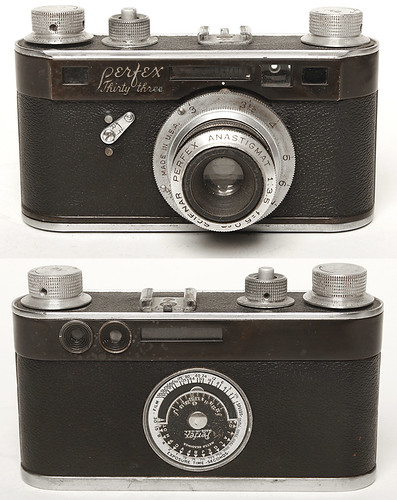
|
| Perfex Thirty-Three with name cast in body image by Rick Soloway (Image rights) |

|
| Perfex Thirty-Three with riveted nameplate image by Rick Oleson (Image rights) |
The Fifty-Five is essentially a further refined version of the Forty-Four. It also was introduced in 1940 along with the Thirty-Three. This model survived WWII and was discontinued in 1947. Early models include the extinction meter that was used on the Forty-Four and Thirty-Three models, while later models delete this feature. Interestingly, both models use the same instruction manual; the instruction manual supplied with the later non-extinction meter models uses very obviously edited photos in which the extinction meter that appeared on the camera that was photographed for the original manual is simply covered up.
Shutter speeds range from 1 second to 1/1250 second, with slow speeds (1, 1/2, 1/5, 1/10 second, and B) being accessed by a separate dial on the face of the camera. The slow speed dial must be wound in addition to the normal shutter winding. As noted above, this arrangement was also used on late model Forty-Four cameras, as that model was phased out.
The Fifty-Five was offered with one of four different standard lenses, listed in order of original cost from lowest to highest:
- 2-inch f/3.5 Scienar
- 2-inch f/3.5 Wollensak Perfex Velostigmat
- 2-inch f/2.8 Scienar
- 2-inch f/2.8 Wollensak Perfex Velostigmat
Also offered were a 6-inch f/4.5 and a 4-inch f/4.5 telephoto. The 6-inch lens was fitted with a special "micromatic focusing mount". Other accessories that were available for this camera were a Perfex Flash Gun, and a range of lens extension tubes from 11/32-inch up to 6-inch. A leather "eveready" case was also offered.
|
|

|
| Perfex Fifty-Five - rear image by Tarn McDaddo (Image rights) |

|
| Perfex Fifty-Five - Second version, no extinction meter. This photo shows camera with cable release adapter fitted. image by Tarn McDaddo (Image rights) |

|
| Perfex Flash Gun with Box image by Tarn McDaddo (Image rights) |
War Years
Sometime during 1941, another new model was introduced, named the Twenty-Two. This model was built between 1941 and 1945. It appears that this camera replaced both the Thirty-Three and Forty-Four, and became the "entry level" version of the continuing Fifty-Five model. The primary features of the camera appear to be identical to the Fifty-Five, with an extinction meter and the Fifty-Five's slow speed dial and rewind button. However, the top plate of the camera is usually blacked out like a Thirty-Three, with a name plate riveted onto the top plate instead of the name being cast into the face of the body casting (similar to some Thirty-Three cameras with riveted name plates). Some Twenty-Two cameras are seen with a silver-colored top plate. It is very likely that the Twenty-Two was assembled using old Thirty-Three (in black) and Forty-Four (in silver) body castings, with the Twenty-Two name plate riveted into place, the rest of the camera being comprised of Fifty-Five parts. The specs of the camera are identical to the contemporary Fifty-Five at the time; however, the Twenty-Two was only offered with the basic Scienar f/3.5 lens, while the Fifty-Five continued to be offered with higher-spec lenses.

|
| Perfex Twenty-Two Silver top version with silver nameplate image by Tarn McDaddo (Image rights) |
Post-War
The de Luxe is much the same as the earlier models, but has a stamped metal body instead of a cast one. It does not include the extinction meter of earlier models, and features redesigned shutter winding and film rewind knobs.
The standard lens for the de Luxe is the Wollensak 50mm f/2.8. A high-speed Wollensak Raptar 50mm f/2.0 was offered as an optional upgrade. Also offered was a Wollensak 101mm f/3.5 telephoto lens.
After the introduction of the One-O-One and One-O-Two cameras (see below), the de Luxe also was released with the in-body shutter speed controls deleted, and fitted with a Kodak Ektar lens mounted in a Compur leaf shutter. This lens/shutter combination is the distinguishing feature between the later de Luxe cameras and the One-O-One and One-O-Two cameras.
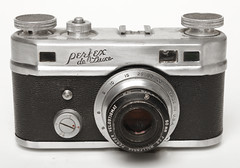
|
| Perfex de Luxe image by Rick Soloway (Image rights) |
The One-O-One and One-O-Two were introduced in 1948 and have an f4.5 and f3.5 lens respectively. Like the later de Luxe models, they differ from the earlier Perfex models by having lenses set into leaf shutters rather than using focal plane shutters. While the body shape is the same as other Perfex models, the shutter speed controls have been deleted from both the shutter button surround and the slow speed dial on the front of the camera. They also lack the extinction meters that were standard on the pre-war models.
The One-O-One and One-O-Two cameras use Wollensak lenses set into Wollensak "Alphax" leaf shutters.
Cee-ay 35
The Cee-Ay 35 was introduced in 1949; but few were made before Perfex sold the design to Ciro who sold a slightly-modified version as the Ciro 35. This model continued after Ciro was absorbed by Graflex.
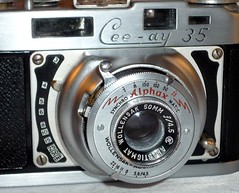
|
| Cee-Ay 35 image by Manuel Barriga (Image rights) |
Links
- Perfex Fifty-Five user manual at Butkus.org
- Perfex De Luxe user manual at Butkus.org
- Speed Candid Review at Scott's Photgraphica
- Speed Candid advertisement January, 1939 Popular Photography magazine
- Details of several Perfex models at Cameraquest
- Perfex Fifty-Five review (archived)
- Perfex Delux, Perfex one-O-one, Perfex Fifty-Five on www.collection-appareils.fr by Sylvain Halgand (in French)
| Companies of Chicago (Illinois) |
| Adams & Westlake | Central Camera Co. | American Advertising and Research Co. | Bernard | Burke & James | Busch | Calumet | Candid | Chicago Aerial | Chicago Camera Co. | Chicago Ferrotype Company | Deardorff | De Vry | Drucker | Galter | Geiss | Herold | Imperial | Kemper | Lennor Engineering Co. | Metropolitan Industries | Monarch | Montgomery Ward | Pho-Tak | QRS Company | Rolls | Sans & Streiffe | Sears | Seymour | Spartus | The Camera Man | United States Camera Co. | Western Camera Manufacturing Co. | Yale | Zar | Zenith |
| Chicago in depth: The Chicago Cluster, a bakelite trust? |
